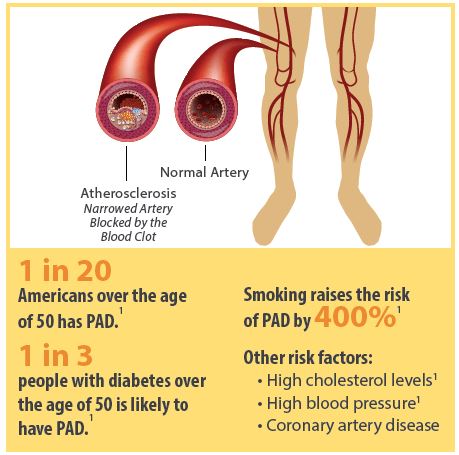Peripheral Artery Disease and Critical Limb Ischemia
Peripheral Artery Disease (PAD) is a disease in which plaque builds up in the arteries that carry blood to the head, organs, and limbs. When this occurs, the plaque can harden and narrow the arteries. This limits the flow of oxygen-rich blood to your organs and other parts of your body, with lower extremity (leg) vessels most commonly affected.
Symptoms, risks factors and complications of PAD
PAD is a common, yet serious disease with over 18 million Americans suffering from the disorder. Risk factors include:
- Advanced age
- Tobacco abuse
- Hypertension
- Diabetes
Although symptoms vary in severity, classic leg pain with exertion, known as classic claudication, only presents in 10-35 percent of the population. This often makes early diagnosis difficult. Other symptoms include:
- Leg muscle tiredness and heaviness, or cramping
- Toes or feet that look pale, doscolored or blue
- Leg or foot pain that disturbs sleep
- Sores or wounds on toes, feet or legs that heal slowly or not at all
- One leg or foot that feels colder than the other
- Thick or yellow toenails that aren't growing

Critical Limb Ischemia
When PAD advances to the extreme stage, the lower limbs become susceptible to Critical Limb Ischemia (CLI). CLI is a severe form of PAD, which leads to ulceration and/or tissue loss. Approximately 25 percent of patients with CLI will have an amputation within one year. In the United States, 130,000 amputations are performed annually.
Once a patient has an amputation, there is a 27 percent chance they will have one or more additional amputations within one year. Following the initial lower extremity amputation, over half of those patients will have the other leg amputated in the next two to three years.
According to Centers for Medicare and Medicaid (CMS):
- 60-80 percent of Medicare patients never walk again after a lower limb amputation.
- Most individuals are never able to live independently after an amputation, leading to
- depression,
- chronic pain
- and a lesser quality of life.
- Additionally, mortality rates as high as 20 percent within six months from diagnosis and diabetics with amputation secondary to PAD have a five year mortality exceeding 90 percent.
Comprehensive Critical Limb Ischemia Program at The Christ Hospital Health Network
At The Christ Hospital Health Network, our team of experts have developed a comprehensive CLI program, led by Dr. JD Corl , Dr. Mark Harding, Dr. En Yaw Hong, Dr. Sasidhar Kilaru, Dr. James Kong , and Dr. Christopher Paprzycki. The overall goal of our program is to prevent amputation and improve quality of life. This critical intervention is accomplished by educating patients and healthcare providers to recognize the signs of PAD and CLI, as well as the available treatment options. According to CMS, most amputee patients never received a procedure that looked to improve revascularization (open vessels via angioplasty with balloon/stents) prior to their amputation, highlighting why this care is so vital.
Secondly, our goal of the program is to create an easy way for patients to receive care with a dedicated nurse coordinator and scheduler. Our expert care team will organize the workup for potential interventional procedures. They will also follow the patient through the process until the wound is healed by monitoring and providing good lines of communication to all specialist involved.
Advanced care for CLI close to home
Comprehensive Critical Limb Ischemia Programs improve limb salvage rates from 36 percent to 86 percent over those hospitals who do not have a dedicated team. This type of coordinated care and multi-disciplinary approach at The Christ Hospital Health Network is the first in the Greater Cincinnati region.
Our techniques and technology used to treat complex PAD and CLI are far more advanced than any other hospital in the region, and our team approach is one of a kind. The dedication and commitment of this program has already impacted many patients. Please call 513-557-LIMB (5462) to refer a patient to the program.